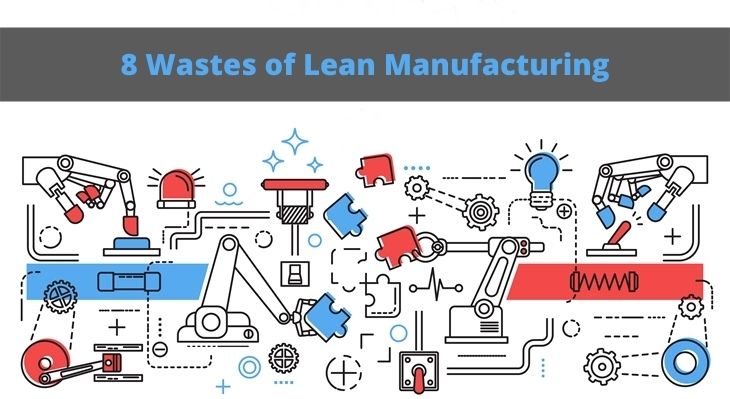Lean manufacturing seeks to eliminate everything that the end consumer does not perceive as value.
The basic foundation of the lean manufacturing management philosophy is to combat waste. However, it is not always possible to eliminate them.
In this article, you will learn about the 8 lean wastes that every organization must constantly seek to extinguish and how to avoid them.
What Exactly is Waste in Lean Manufacturing?
In Lean, waste is any action that consumes resources but does not add value to the end consumer.
In fact, activities that actually create value for customers are only a small part of the entire work process.
That is why organizations should concentrate on reducing waste activities as much as possible.
In doing so, organizations can recognize vital opportunities to enhance their overall performance.
By reducing inventories and streamlining processes, the industry obtains agility and optimization of production time.
By continuously eliminating waste generated throughout the process, you can increase your level of competitiveness and, consequently, remain more sustainable in the market.
8 Wastes of Lean Manufacturing
The defects occur when a product has a fault that does not allow the proper use of it.
This occurrence can result in the refraction of a component of the product or the remodeling of the entire manufacturing process.
This waste considers the production of defective products generated by the process, which are later reworked or scrapped.
To avoid the incidence of defects, create a process to detect failures. Identify one or more frequent defects and focus on resolving them.
Once identified, rebuild the process so that it does not generate defects.
If the new process works, make it the default in your manufacturing system.
Overproduction is one of the 8 wastes of lean manufacturing widely detected in companies.
This waste refers to producing in excess, that is, obtaining more material or information output than necessary.
Overproduction can increase storage costs, overload the production flow, mask system failures, and increase delivery times for the customer.
In order to get around this waste, many companies use the Just-in-Time (JIT) system that produces as needed to avoid inventory management problems.
To avoid overproduction in the company, implement the Takt Time concept to synchronize the pace of production with the pace of sales.
Or you can use a Kanban system to control the quantity of production at all the steps involved.
Also Discover: 5 Key Objectives of Lean Manufacturing
The transport is a quite significant waste of lean manufacturing. It refers to an unnecessary displacement of inventory, equipment, and materials, either internally or externally.
It is worth remembering that all transport is a waste, as it does not add value to the product, however, it is often necessary for the process. Therefore, since it is a necessary evil, it must be minimized.
To combat that, it is necessary to have all the components close, choose the route well, analyzing the total costs and the possibilities of work, in addition to seeking the flow of a single product.
This waste refers to the inoperability of employees, factory machines, and other resources in the process. We know that each stage of a process has different capabilities.
This waiting time, in most cases, is linked to failures in any of the teams responsible for part of the process. The consequences can range from overproduction to sudden stock-outs.
Some measures to reduce waiting during production include, implementing a continuous-flow or a few-step process.
Or using concepts such as Takt Time and Just-in-Time, which help in the distribution of activities, creating a proper workflow.
Excess processing is one of the common wastes of lean manufacturing when there is no systematization in the company.
This waste comprises improper processing, in addition to what the customer requests, that is, the lack of compliance with a logical sequence of operation of the process.
To eliminate this waste, it is necessary to recognize what the customer really needs, avoid rework, be careful with unnecessary activities, and implement standardized processes.
It is also necessary to study the company’s process in order to get rid of this waste.
Inventory refers to raw material accumulated in exaggeration, due to internal information exchange errors, or problems with supplier deliveries.
Excess inventory can be caused by a wrong estimate at the time of the order or misaligned production process that produces beyond demand.
To avoid this waste of lean manufacturing, synchronize the production and purchase of raw materials with customer orders, and decrease buffers (storage) between production steps.
This waste refers to the excessive and unnecessary movement of equipment or employees in the process.
During production, the team must have the necessary materials to conduct the processes. If employees need to move around to get what they need, waste is generated.
The time spent on these movements could be used in order to increase the company’s productivity and add value to the product or service.
There are several ways to eliminate this waste, through a good organization of the work, an optimization of the layout, and mainly, leaving the materials and tools close to the place where the process is carried out.
The Lean system involves only the 7 wastes mentioned above, but the waste of human potential is also considered one of the 8 wastes of lean manufacturing.
The waste of unused talent occurs when management does not take advantage of the potential of its employees.
It is the manager’s role to identify the most suitable activities for each worker. In addition, always seek to motivate and develop employees.
The company gains a lot in results when these professionals are motivated and are encouraged to propose ideas.
You may also like to read: 8 Benefits of Lean Manufacturing You Need to Know

